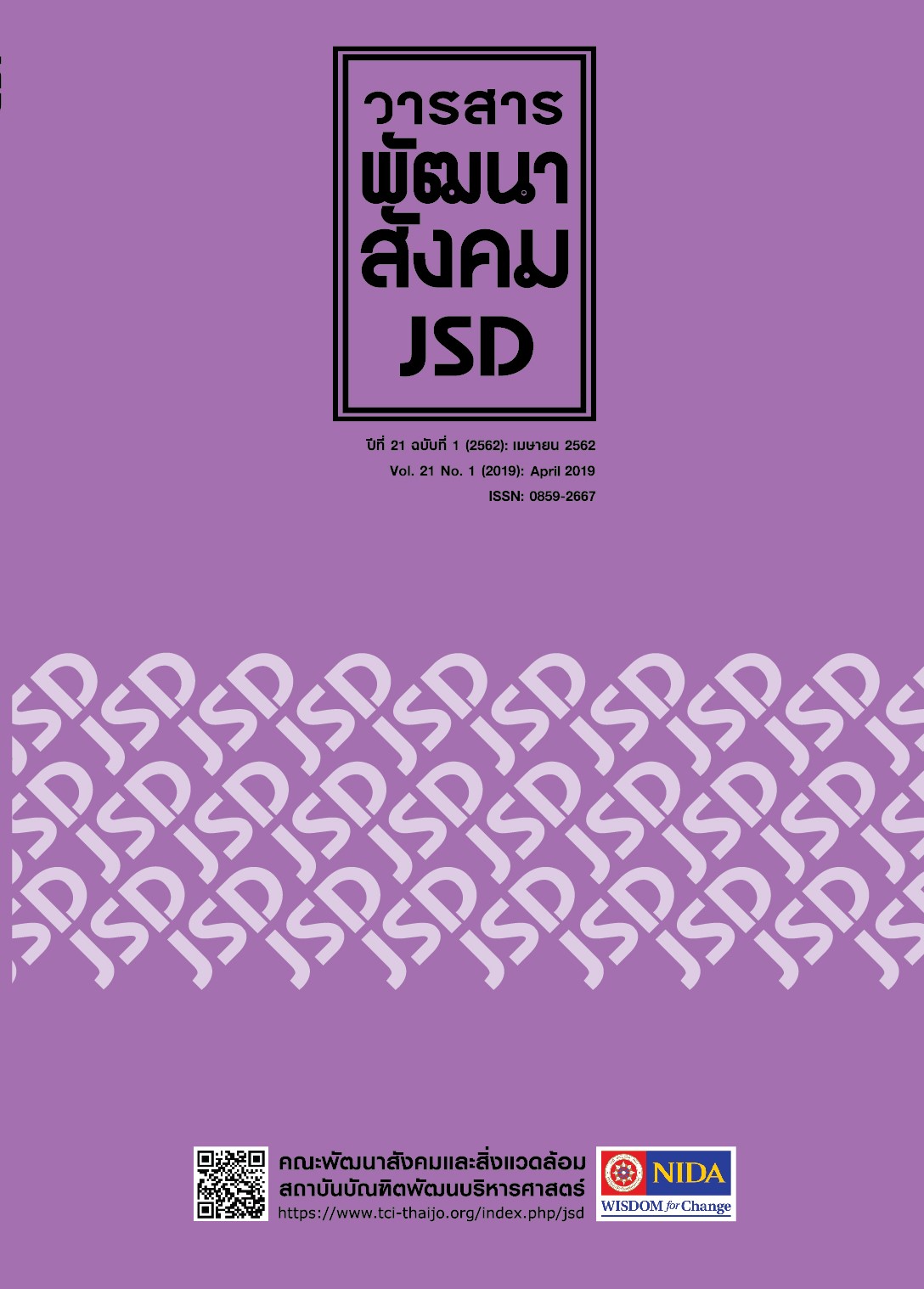Distance People: Communication of Skipped- Generation Household
Main Article Content
Abstract
This study explored the relationships among family members of skippedgeneration households, presenting views of elderly parents ( Grandparents) in a skippedgeneration household on how they communicate and maintain the relationship with their migrant children. There are likely to be more distance of relationship. This study is part of the research project "Migration and Skipped-Generation Households in Thailand" which is a qualitative study. This study found that there are two channels to get in touch: 1) getting back home, 2) mobile phone communication. There is no correspondence through the writing of letters which used to be a popular communication channel before the development of communication, as in the present.
Article Details
How to Cite
Thianlai, K. ., & Hutaphaed, W. . (2019). Distance People: Communication of Skipped- Generation Household. Journal of Social Development and Management Strategy, 21(1), 59–76. retrieved from https://so04.tci-thaijo.org/index.php/jsd/article/view/187772
Section
บทความวิจัย Research Article
References
Abas MA, Punpuing S, Jirapramukpitak T, Guest PT, Tangchonlatip K, Leese M, Prince M. Ruralurban migration and depression in ageing family members left behind.
Br J Psychiatry. 2009;195(1):54-60
Bengtson, V. L., & Schrader, S. S. (1982). Parent-child relations. In D. Mangen & W. Peterson (Eds.). Handbook of research instruments in social gerontology, Vol. 2. University of
Minnesota Press, Minneapolis: 115-185.
Bengtson, V. L. & Robert L.N. ( 1991) . Intergenerational Solidarity in Aging Families: An Example of Formal Theory Construction. Journal of Marriage and the Family, Vol.
53, No. 4, pp.856-870.
Darawuttimaprakorn, N. & Punpuing, S. (2010). Living Arrangements and Elderly Depression: Kanchanaburi DSS,Thailand. In Population Association of America 2010 Annual
Meeting Program. Organized by the University of California.
Dwyer, J. W. , Lee, G. R. , & Jankowski, T. B. ( 1994) . Reciprocity, elder satisfaction, and caregiver stress and burden:The exchange of aid in the family caregiving relationship.
Journal of Marriage and the Family, 35-43.
National Statistical Office. (2013). The labor force survey 2013. [In Thai].
Narongchai, W & Ayuwat, D. (2011). Patterns of Co-resident of Skipped-generation in Isan Migrant Family. KKU Institutional Research Journal. 11 (3): July - September. 101-110. [In Thai].
Pitikultang, S. (2009). Situation and trend of Thai family. In Thai family: from diversity to harmony happiness and healthy. Bangkok: Department of Family Health, Mahidol University. [In Thai].
Podhisita, C. (2011). Thai Family and Household Changes: What We Don’t Know?. In IPSR Annual Report 2011: Thailand's Population in Transition: A Turning Point for Thai Society. Nakhon Prathom: Institute for Population and Social Research, Mahidol University. [In Thai].
Potts, N.L., Mandleco, B.L. (2002). Pediatric nursing: Caring for children and their families.
United States of America: Delmar Thomson Learning.
Roberts, R. E. L. & Bengtson, V. L. ( 1990) . Is intergenerational solidarity a unidimensional construct? A second test of a formal model. Journal of Gerontology. 45(1) pp.12-20.
Roberts, R. E. L. , Richards, L.N. , & Bengtson, V. L. ( 1991) . Intergenerational solidarity in families: Untangling the ties that bind. In S. K. Pfeifer & M. B. Sussman (Eds.). Marriage and Family Review, Vol. 16 : pp.11-46.
Sutinyamanee, V. ( 2 0 1 6 ) . Intergenerational Solidarity in Urban Area: Support and Assistance in Thai Families. Proceedings of the 11th Srinaksarinwirot University Research Conference, Thailand, 28-29 June 2016. [In Thai]
UNFPA. (2016). The State of Thailand’s Population 2015 Features of Thai Families in the Era of Low Fertility and Longevity. Bangkok: UNFPA. [In Thai].
Br J Psychiatry. 2009;195(1):54-60
Bengtson, V. L., & Schrader, S. S. (1982). Parent-child relations. In D. Mangen & W. Peterson (Eds.). Handbook of research instruments in social gerontology, Vol. 2. University of
Minnesota Press, Minneapolis: 115-185.
Bengtson, V. L. & Robert L.N. ( 1991) . Intergenerational Solidarity in Aging Families: An Example of Formal Theory Construction. Journal of Marriage and the Family, Vol.
53, No. 4, pp.856-870.
Darawuttimaprakorn, N. & Punpuing, S. (2010). Living Arrangements and Elderly Depression: Kanchanaburi DSS,Thailand. In Population Association of America 2010 Annual
Meeting Program. Organized by the University of California.
Dwyer, J. W. , Lee, G. R. , & Jankowski, T. B. ( 1994) . Reciprocity, elder satisfaction, and caregiver stress and burden:The exchange of aid in the family caregiving relationship.
Journal of Marriage and the Family, 35-43.
National Statistical Office. (2013). The labor force survey 2013. [In Thai].
Narongchai, W & Ayuwat, D. (2011). Patterns of Co-resident of Skipped-generation in Isan Migrant Family. KKU Institutional Research Journal. 11 (3): July - September. 101-110. [In Thai].
Pitikultang, S. (2009). Situation and trend of Thai family. In Thai family: from diversity to harmony happiness and healthy. Bangkok: Department of Family Health, Mahidol University. [In Thai].
Podhisita, C. (2011). Thai Family and Household Changes: What We Don’t Know?. In IPSR Annual Report 2011: Thailand's Population in Transition: A Turning Point for Thai Society. Nakhon Prathom: Institute for Population and Social Research, Mahidol University. [In Thai].
Potts, N.L., Mandleco, B.L. (2002). Pediatric nursing: Caring for children and their families.
United States of America: Delmar Thomson Learning.
Roberts, R. E. L. & Bengtson, V. L. ( 1990) . Is intergenerational solidarity a unidimensional construct? A second test of a formal model. Journal of Gerontology. 45(1) pp.12-20.
Roberts, R. E. L. , Richards, L.N. , & Bengtson, V. L. ( 1991) . Intergenerational solidarity in families: Untangling the ties that bind. In S. K. Pfeifer & M. B. Sussman (Eds.). Marriage and Family Review, Vol. 16 : pp.11-46.
Sutinyamanee, V. ( 2 0 1 6 ) . Intergenerational Solidarity in Urban Area: Support and Assistance in Thai Families. Proceedings of the 11th Srinaksarinwirot University Research Conference, Thailand, 28-29 June 2016. [In Thai]
UNFPA. (2016). The State of Thailand’s Population 2015 Features of Thai Families in the Era of Low Fertility and Longevity. Bangkok: UNFPA. [In Thai].


